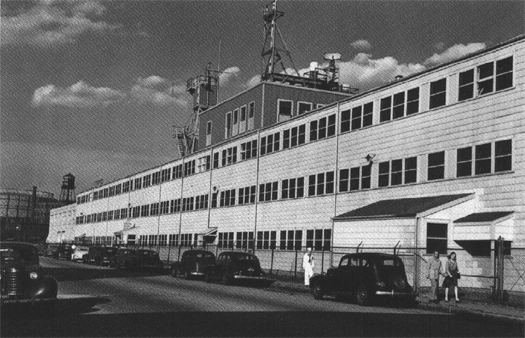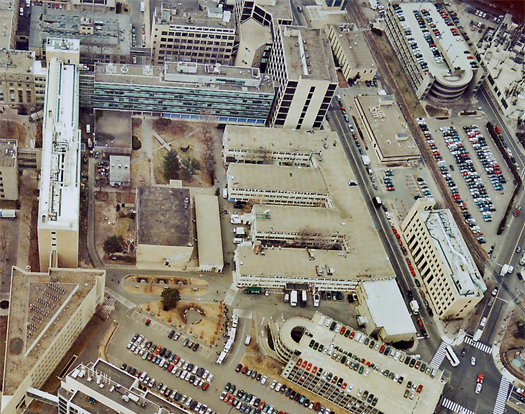

[Building 20 at MIT, a “250,000-square foot wood building [that] hosted the development of many important research disciplines from Chomskyan linguistics to the new style of computing promoted by early hackers”.]
1. Alexis Madrigal writes about “Low Road” buildings:
…startup lore says that many companies were founded in garages, attics, and warehouses. Once word got around, companies started copying the formula. They stuck stylized cube farms into faux warehouses and figured that would work. The coolness of these operations would help them look cool and retain employees. Keep scaling that idea up and you get Apple’s ultrahip mega headquarters, which is part spaceship and part Apple Store.
But as Stewart Brand argued in his pathbreaking essay, “‘Nobody Cares What You Do in There’: The Low Road,” it’s not hip buildings that foster creativity but crappy ones.
“Low Road buildings are low-visibility, low-rent, no-style, high-turnover,” Brand wrote. “Most of the world’s work is done in Low Road buildings, and even in rich societies the most inventive creativity, especially youthful creativity, will be found in Low Road buildings taking full advantage of the license to try things.”
Brand’s essay originally appeared in his book, How Buildings Learn, and has just been re-released as part of The Innovator’s Cookbook, a new Steven Johnson-edited tome of great essays about inventing stuff. It couldn’t come at a better time. The aesthetic of innovation now dominates the startup scene, but it’s like the skeleton of a long-dead invention beast. The point of a Low Road building isn’t that it looks any particular way but rather that you could do anything with and in them. “It has to do with freedom,” as Brand put it.
While Madrigal is writing for the Atlantic‘s Technology channel, and is consequently concerned with Low Road buildings as the places in which technological innovation happens, the thing that interests me here is what the Low Road building says about architecture. That is, if Building 20 is where innovation happens, but Apple’s megaheadquarters are where architects get involved, then is architecture’s relationship to innovation merely that architects get involved with an organization after it has lost the capacity to innovate? Is architecture’s relationship with innovative organizations primarily that it instantiates their ossification?
2. Or is there a role for architects to play in the spatial structuring of innovative and vibrant organizations? If so, what does this architecture look like? Madrigal and Brand suggest that, whatever this architecture might be, it certainly doesn’t look like Norman Foster and Frank Gehry — whatever the merits of their work may be.
Dan Hill speculates about such an architecture in an old City of Sound post:
“Brand uses this point about the endless productivity of these old spaces to reinforce one of Jane Jacobs: that new ideas generally can’t come from new buildings (The Death and Life of Great American Cities). However, if the Smithsons had attempted to design Sheffield University – a defiantly new building – with the characteristics Brand was looking for in old buildings, perhaps the situation is more subtle than Brand and Jacobs suggest? One hopes so, as much as it makes good sense to reuse suitable old built environment. There are strong ideas in Gehry’s building, in terms of creating ‘trading zones’ forcing disciplines together (more on this theme in a forthcoming entry on Richard MacCormac’s new Broadcasting House building) and it’s important to resist forgoing innovation and modernity in such buildings in favour of simply lobbing up portakabins for the sake of ongoing adaptability. Adaptability and modernity surely needn’t be mutually exclusive.”
(Another City of Sound post from the same time period discusses the Smithson’s work at Sheffield University.)
3. Commenting on Madrigal’s piece, Bill Woods adds a quote from C. Northcote Parkinson’s Parkinson’s Law:
It is now known that a perfection of planned layout is achieved only by institutions on the point of collapse. This apparently paradoxical conclusion is based upon a wealth of archaeological and historical research, … A study and comparison of these [buildings] has tended to prove that perfection of planning is a symptom of decay. During a period of exciting discovery or progress there is no time to plan the perfect headquarters. The time for that comes later, when all the important work has been done. Perfection, we know, is finality; and finality is death.
Satirical or not, it seems that there is a useful lesson for architects in this, as it would be terrifically sad if we defined architecture so that great architecture is possible only in an era of decay.
4. Finally, I’m reminded of a comment that Bryan Boyer made in an extended discussion at Rory Hyde’s blog at the beginning of the year. Boyer described his thesis work (which proposed a new capitol for the United States) as being an investigation into “the organizational consequences of spatial decisions made without any spatial understanding”. It seems to me that, if there is a role for architects to play in the life of organizations or institutions which find themselves in “a period of exciting discovery or progress”, it will almost certainly involve understanding the organizational consequences of spatial decisions — and being able to demonstrate convincingly that architects bring a kind of understanding to those decisions that will improve them as they are made.


great points here. For me this ties in to some of the concepts hinted at by Sola-Morales in that Terrain Vague article. That is, architecture’s traditional role is to give formal expression to the desires of power. These low road buildings, like Sola-Morales’ terrains vagues (not sure how to make that plural), offer a sort of liminal space between the circuits of production and consumption. There is still a relationship to the corporation, the consumer, the market, but as Madrigal states- no one cares what you do! To my mind, this creates a liminal space for inhabitation outside of these circuits but related to them and opens up possibilities for new lines of action.
Not sure about all of this, but it strikes me as an interesting parallel… thoughts?
There’s definitely a parallel. First, in both cases you have a kind of thing (a building, a landscape) that sits outside the traditional role of (architecture, landscape architecture), and so indicates something about what an (architecture, landscape architecture) that embraces a non-traditional role might look like. Second, no one cares what you do!.
That said, I think there is some kind of substantive difference between the way that terrain vague is a liminal space, and the low road is a gestator for future production and consumption. Maybe you could say that (in relationship to circuits of production and consumption) terrain vague occupies a space between, while the low road is an early and weird but included space?
Wouldn’t the built terrain vague be more like ruined factories awaiting squatters and urban explorers, or foreclosed McMansions in suburban Arizona?
[…] Mammoth links to another Atlantic piece, discussing “Low Road” buildings and their importance in […]
[…] low roads and architecture (m.ammoth.us) […]
[…] their own commentary on Madrigal, the writers at m.ammoth.us express a concern about the implications of the argument asking, “if Building 20 is where innovation happens, but […]
The new Central St Martins building in Kings Cross (London) is an interesting case study here.
There’s a lot of back-up from tutors and students that the warren-like, decrepit old building in Soho was a creative spur – e.g. driven to succeed because “You feel you’re better than this corridor” (http://www.guardian.co.uk/education/2011/jun/22/central-saint-martins-artists-designers)
The question is how successfully the Kings X space has been designed for creativity. It sounds like they’ve worked hard to build flexible structures(e.g. http://www.nytimes.com/2011/10/18/fashion/18iht-fcentral18.html) and the tutors are on side – but the question remains, does the CSM ‘brand’ regenerating Kings X leave enough fertile space for students?